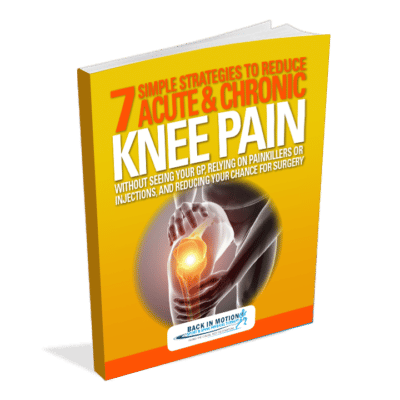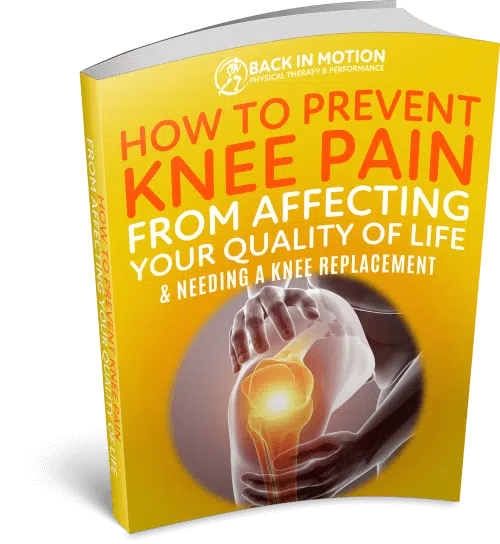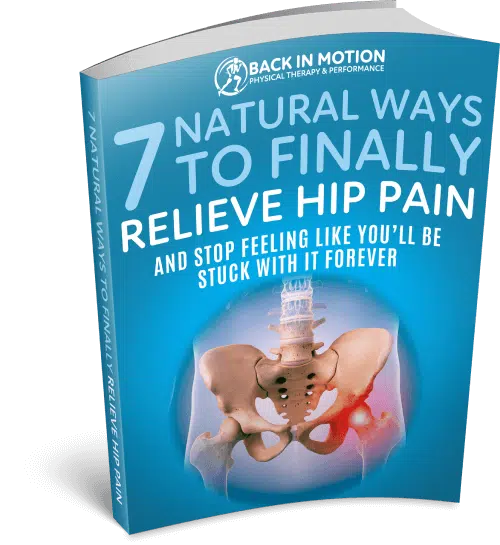A Definitive Guide To Knee Physical Therapy
Knee physical therapy can really help those suffering with any pain or stiffness in their knees. The knee is one of the largest and most complex joints in the body. Naturally, this makes it vulnerable to a variety of injuries. Knee pain or injury is a common complaint affecting people of all ages. There are many medical conditions, including a torn meniscus, infection, ruptured ligament, and torn cartilage that can cause knee pain, stiffness, or reduced mobility.
Some of it may be treated well with self-care measures while others require knee physical therapy. In this post, we’ll show you what you need to know about knee physical therapy.
Knee Physical Therapy Conditions Treat:
Reduced Range of Motion & Stiffness
Reduced range of motion refers to the limited distance and direction your knee joint can move. There are established range of motions which are considered normal for various joints in the body. The joint range of motion declines as you age and can be affected by a number of conditions. Normally your knee should extend to 0 degrees and flex beyond 110 degrees.
Knee Meniscal Tears
Knee meniscal tears are very common among active adults and athlets. Meniscal cartilage acts as shock absorbers between your femur and tibia. Tears in this cartilage can occur when twisting, cutting, being tackled, or even arthritis or aging.
Post-operative Healing
Physical therapy is an integral part of post-operative healing after knee replacement or any other knee surgery. It helps the patient to move around much better than before, improve their balance and strength, and enhance their ability to function again.. In addition, physical therapy acts as a pain reliever.
ACL Tear
ACL or Anterior Cruciate Ligament tear is a common injury during sports activities, especially among athletes who participate in aggressive sports like soccer, football, and basketball. ACL injuries usually occur as a result of rapid change in direction or landing from a jump incorrectly.
Ligament Strain or Partial Tearing
Ligament is the tough fibrous connective tissue that connects bones to other bones in and around joints. Ligament strain or partial tearing in knee occurs due to injury as a result of a sharp change in direction, or muscle weakness. Typically the medial collateral ligament is injured in addition to the ACL.
Knee Weakness
Knee joints bear a lot of human body weight. Simple wear and tear can adversely affect the strength of the knees, causing much pain and discomfort. There are many causes, like arthritis, strains, and sprains, torn cartilage, lack of physical activity that can lead to weak knees or result from weakness of the muscles surrounding the knee.
Patella Femoral Pain Syndrome (PFPS)
Patella Femoral Pain Syndrome is a broad term used to refer to the pain around patella or kneecap and the front of the knee. It is also called a runner’s knee because it is common among sportspersons, particularly females and young adults.
Joint Replacements or Knee Arthritis
Knee Arthritis is a degenerative knee condition where the cartilage of the knee joint gradually wears away. This not only exposes the underlying bone but also develop bony spurs that give rise to knee stiffness, swelling, pain, clicking or grating.
Signs & Symptoms of Knee Meniscal Tear:
✔ Pain after running or walking longer distances
✔ Intermittent swelling of the knee joint
✔ Popping, especially when climbing up or down stairs
✔ Giving way or buckling
✔ Locking (This occurs when a piece of torn meniscus folds on itself and blocks the full range of motion of the knee joint.)
Signs & Symptoms of An ACL Tear:
✔ A loud “pop” or a “popping” sensation in the knee
✔ Severe pain and inability to continue activity
✔ Rapid swelling
✔ Loss of range of motion
✔ A feeling of instability or “giving way” with weight bearing
Signs & Symptoms of Patella Femoral Pain Syndrome
✔ Pain during activities that involve bending of the knee, like squatting or climbing stairs
✔ Pain after sitting for extended periods
✔ Crackling or popping sounds inside the knee when standing up or climbing stairs
✔ Pain that increases with changes to your usual playing surface, sports equipment or activity intensity
Signs & Symptoms of Knee Strain
✔ Pain
✔ Knee swelling
✔ Limited mobility
✔ A popping sound
✔ Inability to hold weight
✔ Buckling of the knee
Signs & Symptoms of Knee Arthritis
✔ Knee Pain usually with a gradual onset after first thing in the morning or after periods of inactivity
✔ Knee Pain often aggravated with weight-bearing activities like walking, going up or down stairs, kneeling and squatting
✔ Knee stiffness
✔ Knee swelling
✔ Warmth around the knee
✔ Clicking or grating
✔ Decreased strength of the lower limb muscles
Want to See How We Can Help You?
Claim A Free 20 Minute Discovery Visit….
What Can You Expect When You Get Knee Physical Therapy?
History
Your physical therapist will collect important information regarding your medical history. They will ask you questions pertaining to the following:
Understanding Your Knee Pain or Stiffness?
There are more than one reason you can develop knee pain. Once you sign up for knee physical therapy, the actual reason for pain or stiffness is found out which may be caused by a sudden injury, overuse injury, or underlying condition, like arthritis. Treatment varies depending on the cause.
What Makes Your knee Pain Better or Worse?
Does your knee hurt when bending? Going up and down stairs? Bending it? These are just some of the questions that your physical therapist will ask you while taking a history.
How Long Have You Endured?
If you are suffering from chronic pain, it isn’t normal – you might be suffering from severe injury. If left untreated, it can become worse over time. No matter whether your knee pain is chronic or acute, it is always wise to consult a professional.
What Treatments Have You Tried?
Your doctors may have recommended you several courses of treatments, like medication, therapy, massage, injections or surgery. Your physical therapist will take account of all these before commencing the therapy.
Physical Examination
Once your physical therapist conducts a solid history about your knee injury, they’ll perform an array of tests to discern what you did to your knee but to also detect any deficits. The following are just a few of the tests and measures a physical therapist will provide:
Range Of Motion Testing
A range of motion refers to how far your knee is bending or straightening. Your physical therapist may use special instruments to test the range of motion of your knee. It will help them direct treatment.
Muscle Strength
As mentioned above, your knee joint is a complex structure. There are many muscular attachments around the knee. Your physical therapist will measure the strength of these muscles while also looking for any imbalances.
Detecting the Cause of Your Injury
Although you came into the clinic for knee physical therapy, your physical therapist will want to discern why you’re having knee pain so you never have to deal with it again. For instance, many times, a knee injury is the result of lack of motion at the foot or ankle or even weakness at the hip. A good knee physical therapist will be able to discern this for you.
Functional Testing
Functional testing assesses if your balance is impaired or excessive stress may be directed to your knee which might be causing pain. Some simple tests may include doing a squat, lunging, stepping up onto a surface, or even performing an array of balance tests.
Treatment:
Once your knee physical therapist detects what is going on with your knee, they’ll be able to provide an array of treatments depending on what you need. Below are just a few of the treatments that a licensed physical therapist can perform:
Myofascial Release
Do you have tight muscles causing your knee pain? A physical therapist can perform myofascial release to take the tension off of your knee.
Taping
When our muscles become weak, sometimes tape is needed to help retrain them so that they function optimally. Knee physical therapy may require this form of treatment.
Functional Exercises
At the end of the day, we want our knee pain to be resolved but we want it to function optimally. For instance, we want to be able to bend, lift, squat, or even play our favorite sport. A physical therapist can help guide you with the right exercises that you’ll need to function optimally.
Patient Education
Sometimes patients need proper education on how to squat, walk, or what type of shoes they should or shouldn’t wear. A physical therapist can help you do this.
Manual Therapy
When our knee isn’t functioning just like we need it to, a physical therapist will need to use manual therapy to help it function more optimally. For instance, if your joint is stiff or not moving enough, they’ll use hands-on techniques to help regain the motion. This form of treatment is essential to many patients needing knee physical therapy.
How To Get Started?
Consult a skilled and experienced physical therapist who specializes in treating patients with knee pain. It not only quickly ease the knee pain but also prevent unnecessary surgeries, painkillers, and help you return to your favorite exercise class and back to being active so that you can enjoy life.
Click here to see all the different ways we can help you with your knee pain. If you’re looking for an appointment or to inquire you can click here, too.

GET YOUR FREE REPORT
7 Simple and Fast Strategies to Reduce Achy Acute and Chronic Knee Pain
About Author: Dr. Scott Gray
Dr. Scott Gray is an internationally recognized and expert physical therapist specializing in sport, athletic, and back and neck injuries. He is the inventor of a revolutionary form of treatment called the GRAY METHOD. This type of treatment unlike others, addresses the CAUSE rather than just your SYMPTOMS with a full body approach. For more information on how to ease or overcome your injury, go to www.backinmotionsspt.com.









